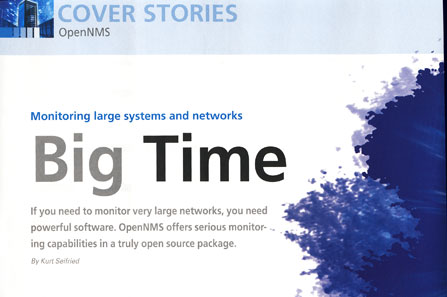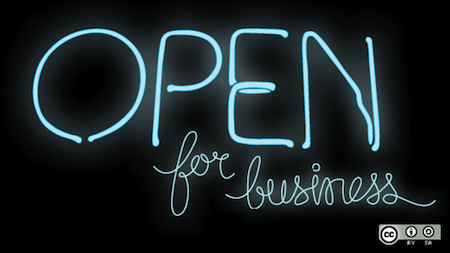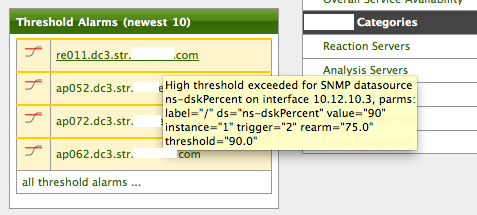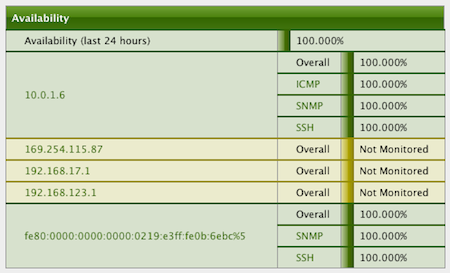I got an e-mail asking for information about OpenNMS. Since we really don’t have a great source of information for things like this, I thought I’d post my reply publicly so everyone can share.
OS support
Q: Which platforms do you have support for?
A: Anything with a 1.5 or later Java JDK. These include Windows, Solaris, Linux and Mac OS X. OpenNMS has been known to run on an IBM OS/390.
Q: Which platforms has native install packages?
A: All of the above, except for the OS/390.
Q: Is it possible to repackage your product?
A: Yes. It is 100% open source software so you can repackage it and redistribute it based on the GPL.
Q: Can we install the product on our hosts?
A: You don’t need to. OpenNMS doesn’t require software to be installed on all hosts, just the OpenNMS server.
Q: Can we run the product in a virtual host?
A: Yes, although for performance reasons it is not recommended.
User interface
Q: Which are the interfaces to your application? Web, java, flash client?
A: Web and iPhone.
Q: Are there any requirements on browsers or operating system to access your user interface?
A: No.
Manage data
Q: List all the supported ways of collecting client side data? (Example: Install agents, use ssh, snmp, Json over http or other)
A: SNMP, WMI, XMP, HTTP, JDBC, JMX and NSClient.
Q: Is it possible to extend your product with our own scripts? If yes which languages are supported?
A: Yes, using any language that exists on the OpenNMS server.
Q: In which ways can we get access to the collected data?
A: Tell me how you want to access it, and I bet you can.
Q: How can we work with the data? Is the collected data stored in a open/accessible format, so that we can access it from other tools? If yes which tools can we use (scripts, tools…)?
A: Collected data is stored in round robin database files. You can access it by querying the application which will return it in XML, dump the data directly from a file into XML or use the JasperReports integration to extract the data as a PDF or CSV file.
Q: How is the graphing and configuration data stored?
A: In XML and properties files.
Q: Which levels of data granularity is supported?
A: For collected data? one second, although five minute polls are configured by default.
Q: For how long can we store the data? Will/can the granularity change over time?
A: For as long as you want. However, the more data you save, the more disk resources will be required. By default OpenNMS polls every five minutes and stores five minute samples for one week. Then the data is rolled up into an hourly average for 62 days. Daily minimum, maximum and average values are stored for one year.
Integration
Q: Is it possible to interface to your product via api or scripts so we can change configuration or retrieve data from other tools?
A: Yes. OpenNMS includes a ReST interface to accomplish most of these functions.
Q: Is it possible to integrate your product with Splunk?
A: Yes.
Q: Is it possible to integrate your product with user access control systems? If yes which (ldap, kerberos, active directory, other)
A: Yes – all of the above.
Q: Is it possible to add host/checks/graphs at runtime with out restart?
A: Sometimes. Some changes, however, still require a restart. This should be corrected by OpenNMS version 1.10.
Notification options
Q: In which ways can we get notifications?
A: How would you like to get notifications? Out of the box you can get e-mails, SMS (via e-mail), XMPP instant messages, microblog (Twitter), IRC as well as an integration with Asterisk to have the system call you. Custom methods can be easily added.
Q: Can the system create tickets in a ticket system? If yes, which?
A: Yes. Out of the box support for Request Tracker, Jira, OTRS, Quickbase and Concursive (CentricCRM). An API exists for others.
Q: Is it possible to set up a escalation chain of who receive the alarms?
A: Yes.
Q: Is it possible set up user patterns for who should be notified? (Timing shifts, escalation)
A: Yes.
Q: Is it possible to set up dependencies to prevent flooding of alarms?
A: Yes.
Redundancy
Q: How do we set up redundancy across different data centers and in one data center?
Read the white paper or the wiki.
Q: Can we setup the redundancy in master-master mode?
A: Yes.
Q: How can we scale your product?
A: Get a big machine. OpenNMS currently has one customer monitoring 66K discreet devices from a single instance, another collecting 1.2M data points every five minutes, one handling 120K syslog messages each minute, another monitoring devices with over 30K virtual interfaces per device, and one with 3000 remote pollers measuring performance back to the central NOC.
Q: What is the number of checks/hosts we can query from one server?
A: We haven’t hit a limit if hardware is not an issue, although I am sure there is one.
SLA (service level agreement)
Q: What are the options for us to measure SLAs?
A: OpenNMS generates availability reports based on outages. The data is customizable – so it would depend on what type of SLA you wanted to measure.
Licenses
Q: Describe the license model.
A: OpenNMS is 100% free and open source software licensed under the GPL.
Q: Is there an extra cost to monitor test environments?
A: No.
Support
Q: What types of support can you offer?
A: Standard Support, 24×7 Emergency Support, and Ultra Support (for those clients who have a need to present data from OpenNMS to their customers).
See: https://www.adventuresinoss.com/pricing
Q: Where are you located?
A: The east coast of the United States, with headquarters in North Carolina.
Q: In which time zone do you have office hours support?
A: Standard support is 7am to 7pm Eastern US time, business days. We do offer 24×7 support for emergencies that occur outside of that time.




